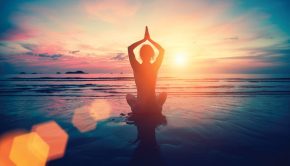EXERCISE TO SLEEP BY
Quell Insomnia and Nighttime Anxiety
by Marlaina Donato
Insomnia plagues millions of Americans, and finding a solution can be difficult when the condition is chronic. Prolonged lack of quality sleep compromises health and sets the stage for depression, high blood pressure, obesity, inflammation, poor memory and even serious risk of heart attack.
The good news is that natural alternatives, especially regular exercise, offer relief. Northwestern University research published in the journal Sleep Medicine even confirms better results from exercise than other natural approaches.
Timing is Everything
Circadian rhythm, the body’s internal clock, governs physiological patterns involving sleep and hunger, and is cued by temperature and sunlight, so timing our exercise is important. Other studies at Northwestern reveal that workouts earlier in the day yield better results because muscles also have their own rhythm (internal clocks) that help them perform more efficiently due to the presence of daylight, and function optimally then. According to the National Sleep Foundation, a decrease in body temperature after an initial increase during physical activity initiates sleep, which also suggests that exercising later in the day, but not before bed, is helpful, as well. Research from Princeton University further shows that exercise can help the brain process stress, helping to minimize anxiety which often accompanies or fosters insomnia.
Long Beach, California, holistic podiatrist Don Kim, creator of The Walking Cure Program, affirms, “The first thing to address is the circadian rhythm—what I call the body’s highest peak and lowest valley. The entire system needs to get used to slowing down.” Kim’s life changed for the better, including his struggles with insomnia, when he made walking a priority after an incapacitating back injury. “Walking is synchronized motion and induces meditative brain waves,” says Kim, who teaches others how to walk for better physical and mental health.
Oxygen is Key
The more oxygen the brain receives, the lower the levels of cortisol that trigger racing thoughts. Other forms of moderate aerobic exercise involving cardio machines, spinning, cross-country skiing, swimming and dancing are also beneficial ways to increase oxygen intake. Chicago fitness expert Stephanie Mansour explains, “Improving circulation helps to increase the body’s energy during the day and helps you wind down at night.”
It’s a common misconception that rushing through the day is the same as engaging in exercise. Mansour elaborates: “Exercising is different than just being busy or working outside, because it’s a time where you connect your mind, body and breath. You’re forced to be present. It’s difficult to think about your to-do list when you’re physically engaged.”
According to Sleep.org, just 10 minutes of regular aerobic activity anytime improves sleep quality significantly. Plus, it abates the likelihood of sleep apnea and restless leg syndrome that sedentary lifestyles can cause or exacerbate.
Cultivating Calm
Restorative yoga instructor Naima Merella, manager of Studio 34, in Philadelphia, Pennsylvania, says, “We’re not taught to value rest, and conditions like feeling overwhelmed and insomnia are the result. Most people in our culture suffer from an overactive fight-or-flight response, so engaging our parasympathetic nervous system, or relaxation response, can balance this.”
Merella advocates yoga, breath work and certain qigong exercises. “One option is to do a more active yoga practice to burn off excess nervous energy, and then end with restorative poses to engage the relaxation response. It all depends on a person’s schedule and what they’re able to do. Ideally, I would suggest doing at least 30 minutes of restorative yoga and breath work before bed, but even a few minutes of a restorative pose or breathing technique can be helpful. I’ve found the kundalini yoga meditation, Shabad Kriya, most helpful for sleeping.”
Renowned yogi Janice Gates, of Marin County, California, also advises physical practice, as well as understanding the foundational teachings. “It’s important to remember that you’re not your anxiety. It’s easy to identify with suffering and conditions that cause it. Yoga supports us to be free of that conditioning. Keep in mind that an issue can be more mental at times and more physiological at other times, so we want to address both with asanas early in the day to balance the nervous system and mindful breathing at bedtime.”
Whichever form of exercise we choose, we should be gentle with ourselves. As Merella reminds us, “The best thing we can do is send ourselves compassion and love.”
Marlaina Donato is a freelance writer, author and multimedia artist. Connect at MarlainaDonato.com.
Image: George Rudy/Shutterstock.com
<













